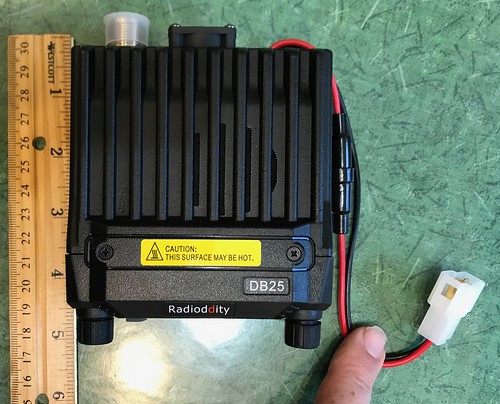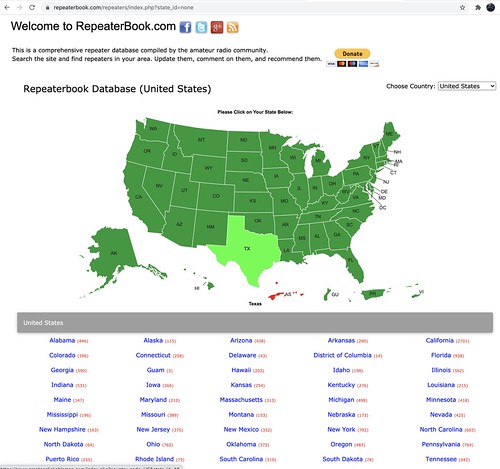After being left without reliable communications during hurricane Harvey I final got my technician's level amateur radio ticket. This allows me to use voice communications on the 2m (144MHz-148MHz) and 70cm (440MHz) radio bands. These are line-of-sight radios that under ideal conditions and a good antenna can reach out about 25 miles. When repeaters (to be explained in a bit) are used the range can be extended drastically, especially when a repeater is connected to the internet.
A repeater is simple a special transceiver which, when it receives a signal at a very specific frequency and including a special code, immediately transmits it at a different frequencies. Repeaters are generally mounted high up on buildings, watertowers, and piggybacked onto other large antennas. This makes their line-of-sight contact footprint extremely large. To use the repeater, you need to know its specific receive and transmit frequencies along with the special code that tells the repeater to repeat the signal.
The Houston area has a lot of ham radio operators which I'd listen to while driving. The radio I had in my vehicle was a small Baofeng, 5 watt unit and a magnetic-mounted antenna. I could hear people well but know one could hear me du to the low power of my unit. So I upgraded to a
Radiooddity DB25 radio.
 Radiooddity DB25
Radiooddity DB25 by
Dr. Mark Merriwether Vorderbruggen, on Flickr, on Flickr, along with extra antenna cable and connectors.
The unit is small.
 5" deep
5" deep by
Dr. Mark Merriwether Vorderbruggen, on Flickr
 4" wide
4" wide by
Dr. Mark Merriwether Vorderbruggen, on Flickr
 2.25" tall
2.25" tall by
Dr. Mark Merriwether Vorderbruggen, on Flickr
Also in the box was the 12VDC power cord and the computer programming cable. This type of transceiver requires a lot more than just turning a dial to use. All the necessary data for each channel can be added using the keypad on the microphone but with a memory of 200 channels that would take FOREVER. Radiooddity makes a PC-compatible programing software for this radio, free with purchase but that software doesn't work on my Mac. Luckily, the free, user-developed software
CHIRP can be used to program the radio's channels. Just download and install it on your computer, plug in the special USB-radio cable into the your computer and radio, attach the radio to a 12VDC power supply...and now the fun really begins.
The first step in programming your radio is to find the repeaters you think you'll be able to reach. The best source for this information is the website
www.repeaterbook.com To get the data, first go to its link for
North American Repeaters which brings up a map of the United States. Click on your state.
I'm in Texas
 Screen Shot 2020-09-19 at 3.38.30 PM
Screen Shot 2020-09-19 at 3.38.30 PM by
Dr. Mark Merriwether Vorderbruggen, on Flickr
This leads to a page where you can then see all the repeaters based on band (frequency), location by county, town, or along major roads, and which ones may be linked to other repeaters for even greater range.
 Screen Shot 2020-09-19 at 3.39.24 PM
Screen Shot 2020-09-19 at 3.39.24 PM by
Dr. Mark Merriwether Vorderbruggen, on Flickr
I want to start programming the
Radiooddity DB25 with 2m bands around Houston so I click on "Houston" under towns and it brings up a list of repeaters. At the top of the page I click on "Export" and choose the CHIRP format.
 Screen Shot 2020-09-19 at 3.40.28 PM
Screen Shot 2020-09-19 at 3.40.28 PM by
Dr. Mark Merriwether Vorderbruggen, on Flickr
This puts a file on my computer that I can import into CHIRP and then upload it onto my new radio. So let's do that.
Opening up CHIRP gives a very boring gray box. The first thing you need to do is download the current channel programing from the radio into CHIRP. To do this click on "Radio" at the top of the program and then choose "Download From Radio". You'll have to pick the particular brand and model of radio so CHIRP knows how to do this. A box pops up with choices. For the Radiooddity DB25 you need to pick "Port" as /dev/cu.usbserial, the vendor as QYT and the model as KT8900D which doesn't make sense until you remember you're dealing with a Chinese clone.
 CHIRP
CHIRP by
Dr. Mark Merriwether Vorderbruggen, on Flickr
A small progress box should pop up showing you're Cloning data from the radio.
 IMG_2995
IMG_2995 by
Dr. Mark Merriwether Vorderbruggen, on Flickr
When the data from the radio has finished downloading the CHIRP box will now look like this:
 IMG_2996
IMG_2996 by
Dr. Mark Merriwether Vorderbruggen, on Flickr
Those cells are where you need to put data to make the radio work. Luckily, CHIRP will do that. Open a New file on CHIRP and import the file you exported from Repeaterbook.com into this new file. It'll look like so:
[img]https://live.staticflickr.com/65535/50358171662_987f3e4c2b.jpg[/img]
IMG_2996 by
Dr. Mark Merriwether Vorderbruggen, on Flickr
Now, copy all those cell and paste them into the blank data file you had cloned from your radio. Save it with a file name that makes sense to you, then you need to upload it to the radio. To do this click on "Radio" at the top of the screen then click on "Upload to Radio". You'll get the same cloning box for a bit then all the data will have transferred. Your radio will turn of then on again all by itself.
The Radiooddity has the ability to scan all 200 channels while at the same time monitor three of those channels in case anything interesting pops up on them. I monitor three local emergency dispatch frequencies while scanning all the other channels. When you first upload all the channels of interest to the DB25 it shows the channel frequency. I find the channel call sign (name) to be more useful and so switch the display as directed in the manual.
Scanning repeaters plus monitoring Houston EMS and fire dispatches.
[img]https://live.staticflickr.com/65535/50357307343_29a81c7e75.jpg[/img]
IMG_3006 by
Dr. Mark Merriwether Vorderbruggen, on Flickr
I'm sure this little writeup has caused more questions than answers. I like this radio. It seems durable and solid. It puts out around 25watts which means people will definitely hear me now. It took about an hour to set up because I had to figure some things out myself. I already had CHIRP files setup from similar radios so I didn't have to spend a lot of time on Repeaterbook getting the information.
After it was all set up and working I decided I like it enough to order a second to use as a basestation inside my house. One of the features of the DB25 is it supports DTMF codes which allow you to use one radio to control another programed with the same codes. This will be good when I'm out working for the Red Cross during disasters but want to send periodic "I'm okay!" signals to the wife and kids even though they don't have ham radio licenses.
Note, as an Amazon affiliate, if you purchase the radio from the link I provided Amazon will pay me a small sales commission .